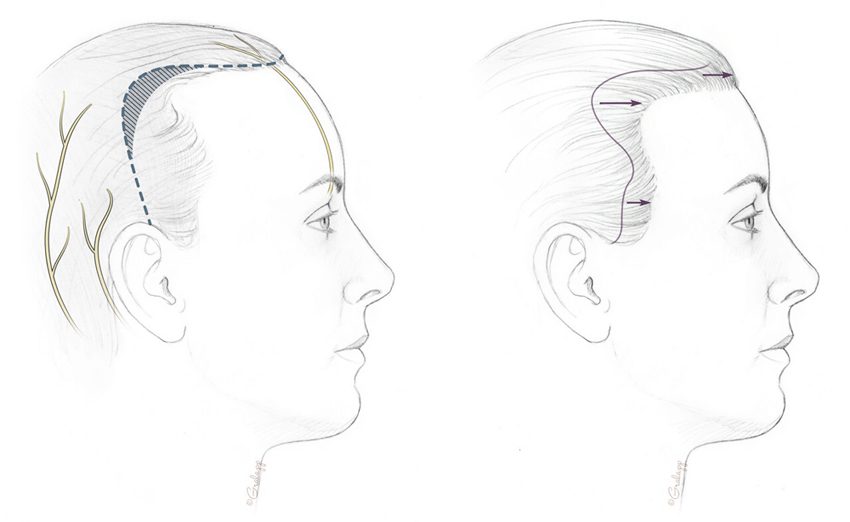
What Are the Differences Between a Female and a Male Hairline?
The upper half of your face tells the world very much about your gender, and your hairline is a critical aspect of facial gender confirmation because it essentially “frames” your entire face. A masculine hairline is typically further back on the skull than a feminine one, creating the appearance of a larger, more prominent forehead. In comparison, the feminine hairline is lower down on the forehead and more rounded in shape with hair appearing more graduated or “wispy” at its edges. If you are seeking a more feminine aspect, you will need to lower your male hairline into the normal feminine range of hairline height and shape.
How Does Hairline Lowering Work Within the Context of Facial Gender Confirmation?
Feminizing hairline lowering, or scalp advancement as it is also known, is ideal for facial gender confirmation candidates who may have a naturally higher hairline and/or larger forehead. It is also not uncommon for us to lower, or reshape the hairline of non-transgender individuals who have receding hairlines. The objective of the procedure is to reduce the amount of height between the eyebrows and the hairline, to bring the position of the scalp forward, and to alter the shape of the hairline. The procedure is usually included within a larger set of procedures that comprise facial feminization, which is typically undertaken in one single session of long format surgery.
How Is Hairline Lowering Performed?
The surgery is performed by making a trichophytic incision along the natural hairline and then bringing the hair-bearing tissue of the scalp forward. Individual hair follicles may then be transplanted after closure to further feminize the shape of the hairline and create a more natural- looking hairline.
What Is the Timeframe for the Healing Process?
Scalp advancement has minimal post-surgery pain. The most common side effect is slight facial swelling in the forehead and the eye area. It may require up to seven days for the swelling and discomfort to subside completely. Accordingly, many patients will take a week off from work, but it is possible to return to light activities after two or three days and normal activity level after a week. Patients may also experience short-term and harmless numbness near the front of the scalp, which will subside after a few months.
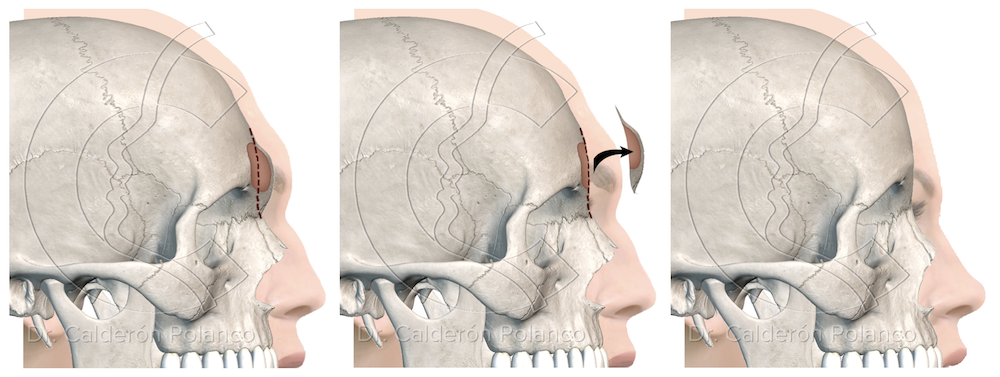
How Does Forehead Contouring and Reduction Enhance Facial Feminization?
El remodelado óseo frontal y supra órbita rio es una de las técnicas más importantes en Feminización Facial. La frente es una de las partes. Más evidentes de la cara, porque supone más de la tercera parte de su superficie.
and essentially dominates and aesthetically balances all other facial features.
The aim of forehead feminization via contouring and reduction within the context of facial gender confirmation is to create a more feminine, “softer” forehead, and reduce the heavy appearance of the male brow. Contouring, along with scalp advancement (hairline lowering) significantly changes the look of a male forehead to become more naturally feminine in appearance. Additionally, any existing congenital facial asymmetries can also be improved by forehead contouring. The procedure shapes the forehead and the bones around the eye sockets, minimizing the heavier bony ridge of a masculine-looking forehead. Contouring “opens up” the appearance of the eyes, helping to transform and feminize the forehead.
How Is Forehead Contouring for Facial Gender Confirmation Surgery Performed?
During your initial surgical consultation, Dr. Deschamps-Braly will make a plan for the correct contour and desired shape of your forehead. Surgical planning is undertaken based on science, artistry, extensive facial gender confirmation experience, and aesthetic intuition. He will catalog a battery of measurements during your consultation which allows him to plan for the most appropriate approach to your surgery. He also utilizes custom-made precision instruments to reshape the hairline, forehead bones, brows, and eye regions to ensure a more feminine appearance.
The procedure begins with an incision either right at, or just behind, the hairline – depending on whether or not the hairline position needs to be repositioned. The exact procedure varies from patient to patient, but most often the brow bone is osteotomized and reconstructed to reduce the size of the forehead, and the orbital bones are shaped to modify masculine characteristics. The frontal bone (between the eyebrows) is removed, shaped, and then reattached so that it does not interfere with the underlying sinus cavity. Forehead contouring is often performed in conjunction with a brow lift or hairline restoration because of the location where the incisions are made.
Which Is Better Stainless Steel or Titanium?
We prefer to use non-magnetic stainless steel wire for reattaching the forehead bone. In part, because this type of wire does not create unwanted delays in airport security, or issues during an MRI if one is needed in the future. While we have had great experiences with titanium plates and screws overall, and our surgical practice has used them since the 1980’s (when the first commercially available titanium plates and screws were introduced) we do not find them appropriate for forehead surgery. If the forehead needs reshaping, or a ridge or concavity needs filling, the doctor will use a biologically inert synthetic material to create a more rounded feminine shape.
Within the context of facial feminization, a brow lift procedure raises the eyebrows into a higher, more feminine position on the face. A brow lift also works to eliminate common telltale signs of aging such as wrinkles on the forehead, crow’s feet, horizontal or vertical lines such as frown lines and furrows between the eyebrows and around the eye.
How Does a Brow Lift (Browplasty) Feminize the Face?
Women tend to have higher more arched brows than men, while men have lower, heavier, and more prominent brows. Among the cluster of surgical procedures that comprise facial feminization and facial gender confirmation surgery, a brow lift is used to raise the eyebrows to a higher, more feminine position on the face.
Will a Brow Lift Also Make Me Look Younger?
Depending on your age, a brow lift may also create a more youthful and rejuvenated appearance. It will improve — or even eliminate — common telltale signs of aging such as “sagging” eyebrows, wrinkles on the forehead, and crow’s feet. The procedure addresses horizontal and vertical lines, such as frown lines and furrows between the eyebrows and around the eye — most specifically with regards to the corrugator muscle — the muscle between the eyebrows where Botox® and Dysport® injections are often placed. Typically, during a brow lift, we will sever the corrugator muscle which eliminates the future need for Botox® and also alleviates vertical wrinkling between the eyebrows permanently.
Do All Brows Need to Be Lifted? Or Is Brow Shaping More Important?
Not all brows need to be lifted. In fact, some just need to be shaped into a more feminine form and aesthetic. Also, depending on your existing facial features, your brows may naturally elevate to a higher position as you get older, so in terms of an aesthetically pleasing brow, the shape and position of the “tail” of the brow is actually more important than its overall height. Additionally, as we age, we may lose facial volume in our temple areas. This loss can be significantly improved upon by restoring volume with a natural filler such as your own body fat via a fat transfer procedure.
How Is a Brow Lift Procedure Performed Within the Context of Facial Feminization Surgery?
Brow lift surgery is performed under general anesthesia usually via an “open” approach during your long format facial feminization surgery session. Although endoscopic brow techniques are common, we achieve better results with an open approach because it allows for better control of the final result. Many plastic surgeons do not offer an open approach because they are not comfortable with its highly technical aspect and opt for a less demanding approach. Precise knowledge of anatomy is required to offer this procedure to our patients and we feel in most cases this open approach provides a superior result. In either surgical technique, an incision is made in the hairline or in front of the hairline, which leaves little to no visible scarring.
Your brow lift may also be performed at the same time as a hairline restoration, feminizing rhinoplasty, or forehead reduction/contouring depending on the scope of your facial feminization transformation.
Feminizing rhinoplasty, or nose surgery, is another common procedure used in facial feminization. Male noses are usually wider and larger and need to be reshaped and refined to appear more feminine. The rhinoplasty procedure reduces the size of the nose by narrowing and/or altering the nose internally, and/or reshaping and moving the nose cartilage. The art of feminizing rhinoplasty is a delicate one. Along with precise surgical skills, your surgeon must also possess a keen artistic eye to be able to visualize how your reshaped nose will appear in harmony with your other facial features.
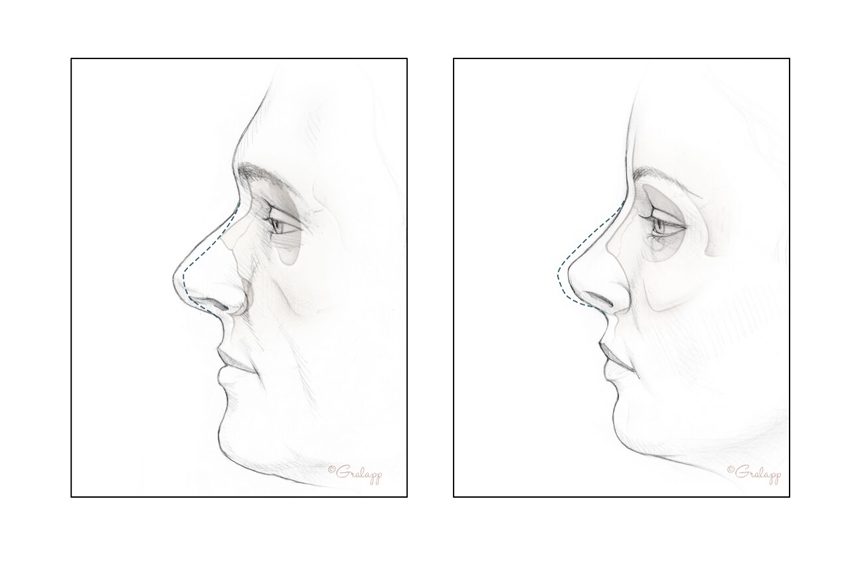
There Are Distinct Differences in Male and Female Noses.
The shape of the male nose is usually larger and more angular than the female nose. The bridge of the nose may also be wider and straighter while in comparison women’s noses are narrower with the nasal tip typically pointing upwards. These differences may appear subtle to the casual eye, but they all constitute the distinguishing characteristics of gender. To make the male nose appear more feminine, it needs to be reshaped and refined. Patients undergoing a rhinoplasty for facial gender confirmation will benefit from a surgeon not only performs a rhinoplasty skillfully but can also do so within the context of a truly feminized forehead. The biggest challenge with feminizing the male nose is ensuring that it retains aesthetic harmony with all other existing or newly feminized facial features. It is critical that your “new nose” still looks like you, and also that it is aesthetically in balance with the rest of your facial structure.
How Does Feminizing Rhinoplasty Create a More “Female” Nose?
Feminizing rhinoplasty reduces the size of the nose and alters its shape and profile to make it appear more feminine. This result is achieved by narrowing and/or altering the nose internally, and/or reshaping and moving the nasal cartilage. The real skill in the procedure is for the surgeon to have an appreciation and deep understanding of the aesthetic qualities of what constitutes a truly “female” nose — so that the patient can achieve their goal of facial gender confirmation.
The Artistry of Rhinoplasty for Facial Gender Confirmation
One of the most common facial gender confirmation surgeries we perform is the revision of another surgeon’s work — this is also true of feminizing rhinoplasties. The art of rhinoplasty surgery is an extremely delicate process — regardless of gender — and it is also one of the most difficult plastic surgery procedures to undertake successfully. Read more about rhinoplasties here.
How Is Feminizing Rhinoplasty Performed Within Facial Gender Confirmation?
Within the context of facial gender confirmation surgery, a feminizing rhinoplasty is almost always performed at the same time as forehead feminization and hairline lowering. This is because if would you alter the hairline, the forehead, and the brows, without also altering the nose, the end result would not be aesthetically balanced. That is why we nearly always recommend a feminizing rhinoplasty within the cluster of surgical procedures included in facial gender confirmation.
Feminizing cheek enhancement gives the cheeks a rounder and smoother feminine appearance. Depending on your existing features and the desired effect, the procedure includes either cheek augmentation or cheek reduction.
Cheek augmentation most often includes inserting implants under the skin to create a fuller more feminine cheek shape. Another way to augment the cheek is via volume enhancement with fat injections (with fat taken from other parts of your body). In comparison, cheek reduction reduces the width and outward prominence of the cheeks allowing for more slender and streamlined facial features.
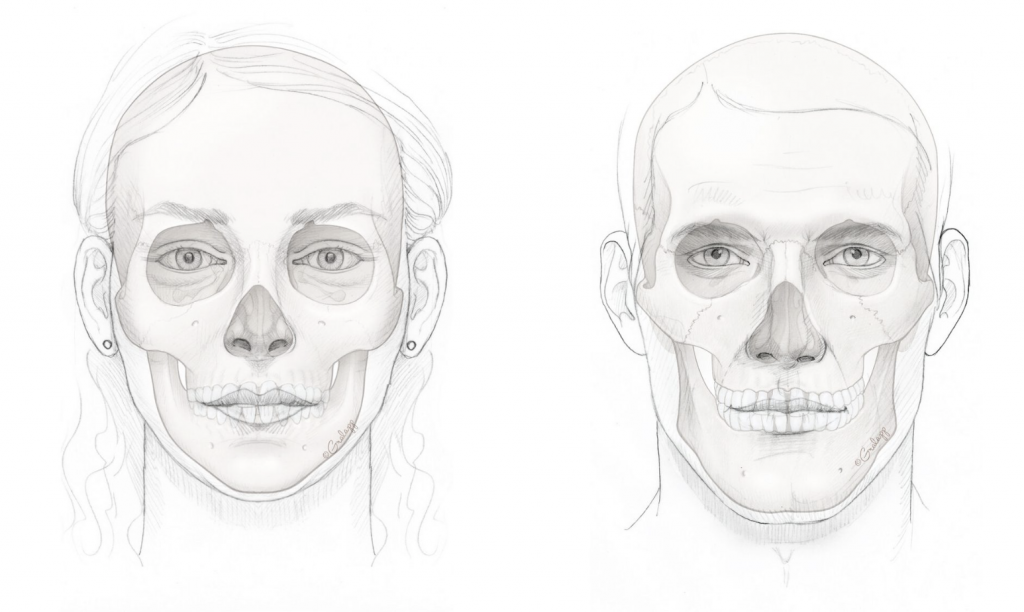
The Differences Between Male and Female Cheeks
Some of the major differences between men’s and women’s faces include cheek shape and size. Men’s cheeks are characterized in part by more angular, chiseled cheeks, whereas a woman’s cheeks are usually more rounded and soft with prominent cheekbones that project further out from the face.
What Is Ftm Masculinizing Cheek Augmentation?
Cheek masculinization surgery is typically included within the cluster of surgical procedures that compromise facial masculinization surgery (FTM) because the cheeks are such a prominent facial feature. To convey a more masculine appearance, the overall shape of the cheekbones is just as important as their size — both being a strong indicator of gender. In addition, certain ethnic groups tend to have larger cheek sizes, that is why we tend to consider cheek size individually within the context of your facial features and your masculinization goals.
How Does Cheek Augmentation Work to Masculinize the Face?
Cheek masculinization surgery creates more angular, chiseled, and masculine-looking cheeks to further the goals of FTM facial confirmation by utilizing some — or all — the following procedures:
Cheek Augmentation (surgical): augmenting the cheeks with lipo-filling or placing implants over the bone and under the skin to increase cheek fullness, or,
Cheek Reduction (surgical): reducing the width and/or the prominence of “chubby” or overly-feminine looking cheeks, or,
Fat Transfer Injections (non-surgical): to improve the size and shape of the cheek without invasive surgery.
The modification of cheeks may require cheek augmentation with implants alone, reshaping the cheekbone via reduction, or increasing cheek volume with fat transfer injections, or a blend of all the three procedures to achieve the desired outcome.
How Is Cheek Augmentation Surgery Performed?
Masculinizing cheek augmentation is performed under general anesthesia with implants inserted through incisions made on the insides of the mouth. The size and shape of the implants will depend on your underlying bone structure and expected outcomes. The underlying bone may also be shaped or contoured as needed. Cheek augmentation leaves no obvious external scarring because all surgical incisions are made inside the mouth and in the scalp.
How Is Non-surgical Cheek Augmentation Via Fat Transfer Performed?
Cheek enhancement via fat transfer is performed by first harvesting fat from your own body–that is injected into the cheeks. This is done in such a way to create more masculine looking cheeks. If you prefer to avoid surgery, this non-surgical procedure is ideal for you.
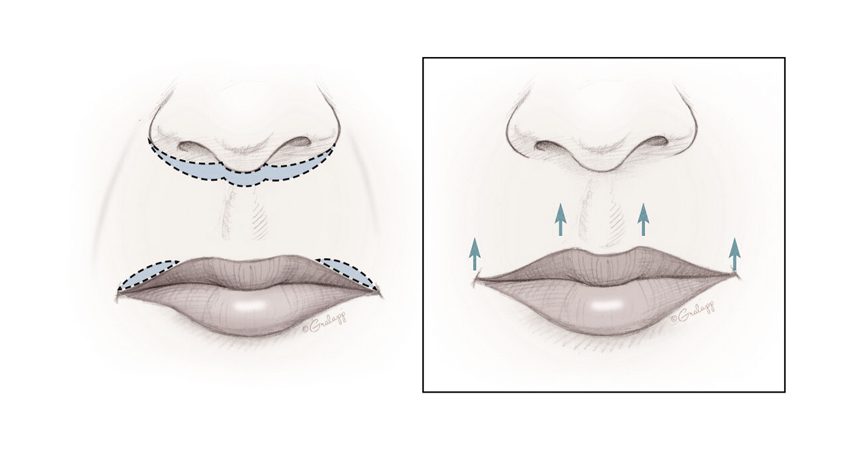
The Differences Between Male and Female Lips
The position, shape, and size of lips on men and women are typically different. Men’s lips tend to be thinner than women’s lips, with fuller, plumper lips being associated with a more feminine look. The distance between the opening of the mouth and the base of the nose is usually longer in men, causing the male lip to appear “flatter” and thinner. Whereas the female lip is usually higher and closer to the base of the nose and fuller in appearance, with the upper teeth slightly exposed.
Lip Feminization for Facial Gender Confirmation: 3 Procedures
Feminizing the lips involves several options for procedures – or all three – depending on your features, age, or desired outcome. Lip feminization is often performed as a part of a facial feminization surgical process. Your surgeon will outline your options and explain the advantages and disadvantages of each procedure. You may need several procedures depending on your desired result and existing facial features:
Lip Lift (Upper Lip Reduction): lifting the upper lip to a more feminine and youthful position.
Lip Augmentation (Lip Filling): filling the lips so they appear fuller, “plumper” and more feminine. Lip augmentation may be done either through the use of injectable fillers or fat transfer injection.
Corners-of-Mouth Lift: Often less of the red part of the lips shows near the corners of the mouth so the corners-of-mouth Lift is done to improve the ratio of the natural “sweep” of the lips and increase the visibility of the red portion.
How Does an Upper Lip Lift Help to Feminize the Lips?
An upper lip lift (upper lip reduction) lifts the upper lip to a more feminine and “open” position to improve the visibility of upper teeth. A lip lift makes the lips – and the entire face – look more feminine by shortening the upper lip, improving the visibility of the upper teeth, and creating a more youthful appearance.
How Does Lip Filling (Lip Augmentation) Help to Feminize the Lips?
Filling the lips so they appear fuller and more feminine can be done either through the use of popular injectable fillers such as Restylane®, or fat transfer injection using your own fatty tissue – the most natural and longer lasting method.
How Does the Corners-of-the-mouth Lift Feminize the Lips?
The corners-of-mouth lift is performed to improve the ratio of the natural “sweep” of the lips and increase the visibility of the red portion of the lips. This procedure focuses exclusively on lifting the corners of your mouth and does not affect lip movement, which is necessary for the expression of your full range of emotions.
How Will I Know Which Procedure the Right One for Me?
There are several ways to plump and feminize the appearance of your lips to achieve your facial gender confirmation goals. Your surgeon will outline your options and explain the advantages and disadvantages of each procedure. You may need several procedures depending on your desired result and existing facial features.
Feminizing chin re-contouring (genioplasty) alters the shape of the male chin by reducing, reshaping, or augmenting (making the chin larger). Most often the male chin is reduced in size and reshaped to be less angular, creating a smoother and more feminine aesthetic. Chin surgery may also involve the elimination of asymmetries – making your features more symmetrical and aesthetically in harmony. Contrary to popular belief, no chin implants are used in chin recontouring other than small screws to hold the bones in their proper position.

There Are Significant Differences Between Male and Female Chins
The shape and appearance of the chin is an extremely important aspect of gender recognition and critical for achieving the goals of facial gender confirmation. In general, male chins tend to be more angular, wider, longer, and squarer with a flat base, while women’s chins tend to be smoother, more rounded, and softer in appearance.
How Does Chin Recontouring Feminize the Face?
Chin re-contouring (genioplasty/mentoplasty) reduces the shape of a large or prominent chin — when a more feminine look is desired. This procedure is intended to impart a natural balance by reducing and reshaping the chin to be smaller, less angular, with a smoother and more feminine aesthetic. The procedure reduces a large male chin, bringing it down to the smaller proportions typical of a female chin. Also, any existing asymmetries are eliminated to increase symmetry and an overall aesthetically pleasing appearance. Chin re-contouring is a procedure often undertaken as part of a facial feminization surgical process.
Are Chin Implants Used for Facial Gender Confirmation?
Many patients ask us about chin implants, but these are typically not used in this type of operation. In fact, it is impossible to feminize a chin with an implant! Any implant will invariably have the effect of enlarging the chin in one dimension or another — the opposite outcome of what we’re aiming to accomplish with a feminizing genioplasty. Also, chin implants have potential problems such as infection due to rejection, shifting of the implant later, and/or possible damage to the roots of the teeth or nerves that give your lips sensation.
Another method we commonly employ for chin contouring is a T-osteotomy, which involves cutting the chin bone and removing a T-shaped piece of bone, and then fusing the remaining bones of the chin together. It is almost impossible to correct both a square jaw and produce a slender “V-Line” shape to the chin — simultaneously — without using this technique for chin recontouring.
The male jaw is usually wider and more angular than the female jaw. Men tend also to have a sharp back “corner” to the jaw, which can be made to appear rounder and smoother through jaw contouring resulting in a more feminine look. The bone of the jaw can also be shaved along its lower edge and chewing muscles reduced to make the jaw more slender. Jaw contouring also helps patients who may have a lopsided face and wish to have their features appear more symmetrical.
How Does Jaw Contouring or Reshaping Feminize the Male Face?
Typically, the shape of the male jaw is wider and higher than the female jaw. Men tend to have wider, heavier-set jawlines than women with a heavier mid-body area and a sharper angle between the chin and jaw as well as a flat base, giving a male jawline a prominent “square” look. Women’s jawlines typically have rounded edges, are more tapered and pointed – even if the jawline may appear square.
Jaw contouring (also known as jaw tapering or jaw reduction) is used to modify and feminize prominent male jawlines as part of facial feminization (gender confirmation) surgery. The back “corner” of the male jaw can also be reshaped to be rounder and smoother. Bone can be shaved off along the lower edge of the jaw and chewing muscles reduced (see: Masseter Muscle Reduction) to make the jawline appear narrower.
How Does Jaw Contouring Feminize the Face?
Jaw contouring works to narrow the overall width and shape of the face, subtly refine jawline angles, and improve the overall proportions of facial features thereby making the face more feminine in appearance. Individuals with asymmetrical or lopsided-appearing faces also benefit from this procedure. The results will look natural and provide balance and harmony to facial proportions to achieve the goals of facial gender confirmation.
What Is Masseter Muscle Reduction?
If your jaw is quite wide in appearance, your surgeon may also perform a masseter muscle reduction to remove some of the masseter muscle. This is a safe procedure when performed by a skilled surgeon, and is suitable for a patient who is willing to perform exercises to maintain mouth opening size. We carefully consider the risks and benefits when offering this surgery because of the increased post-surgical pain and swelling patients may experience. Masseter muscle reduction may also be achieved non-surgically via Botox® or Dysport® injections.
Feminizing Earlobe Reduction Surgery is a plastic surgery procedure that can be undertaken independently, or as part of more extensive facial feminization surgery (FFS). The procedure aesthetically enhances the appearance of the earlobes and cartilage, with the goal of creating an external ear that is naturally feminine-looking in proportions, contour, and appearance.
What Is Feminizing Earlobe Reduction?
Feminizing earlobe reduction is a procedure that may be undertaken independently, or within a cluster of procedures that comprise facial gender confirmation surgery with the aim of reshaping masculine looking ears to make them appear more feminine. This procedure aesthetically enhances the appearance of the earlobes and ear cartilage, with the goal of creating an external ear that is naturally feminine-looking in proportions, contour, and appearance.
How Is Feminizing Earlobe Reduction Surgery Performed?
Feminizing earlobe surgery is often performed in conjunction with a series of facial gender confirmation procedures. Depending on your desired outcome, earlobes may be reduced, reshaped, and cartilage may be sculpted to modify the overall contours of the ear. Feminizing an earlobe can be achieved by reducing and reshaping a larger and longer ear – given that feminine facial features are generally more petite than male features. The earlobe, or the peripheral lobule, is trimmed and reshaped as desired for a more feminine look.
The single most important step in feminizing an ear is crafting a smooth and natural inferior lobe border. Dr. Deschamps-Braly is known for his aesthetic finesse and understanding of what it takes to achieve consistent and aesthetic outcomes.
The Ideal Candidate for Feminizing Earlobe Reduction
Older patients seeking facial feminization are typical candidates for earlobe reduction surgery. The cartilage of the ears continues to grow throughout our lifetime. Gravity over time also causes earlobes to sag, stretch, and enlarge, creating pendulous earlobes, a condition commonly called “megalobe” — which may not look feminine, or aesthetically pleasing.
The Adam’s apple is one of the most recognizable male physical characteristics and as such, reducing its size with a tracheal shave is often one of the most common feminization procedures. The tracheal shave reduces the outward prominence of the thyroid cartilage and gives the throat a more feminine appearance. It is critical that the surgery is done correctly because occasionally the cartilage may grow back. We use special surgical techniques to greatly reduce that possibility.

What Is the Difference Between the Adam’s Apple in Men and Women?
One of the most noticeable gender-related differences between men and women is the presence of a prominent Adam’s apple; the small bump that sits midway on the throat in men, and is still present, but barely noticeable in women. The size of the Adam’s apple can be reduced significantly with a surgical procedure known as a tracheal shave, thyroid cartilage reduction, or Adam’s apple reduction. It involves literally reducing or shaving the thyroid cartilage down to decrease the size of the Adam’s apple to make the neck and throat appear more feminine and further the goals of facial feminization surgery.
How Is an Adam’s Apple Reduction And/or Removal Performed?
Dr. Deschamps-Braly is continually innovating with regards to Adam’s apple reduction (and augmentation via natural implant) techniques within the context of facial gender confirmation surgery. Typically, the procedure involves an incision in the throat just under the chin. The vertical muscles of the throat are then separated to expose the Adam’s apple and the tracheal cartilage is shaved to reduce its size.
We are critical of techniques that place the incisions on the front surface of the throat where potential scarring will be more visible. You don’t want to draw attention to something that you may be trying to draw attention away from! In addition, we have seen a number of patients who have had this incision placed inappropriately on the front of the neck, only then to have the scar stick to the cartilage underneath; and move up and down when the patient speaks or swallows. Obviously, this is not an ideal outcome.
NOTE: It is important that Adam’s apple reduction is performed correctly by a qualified and experienced plastic and craniofacial surgeon. If performed incorrectly, the tracheal cartilage may grow back partially.